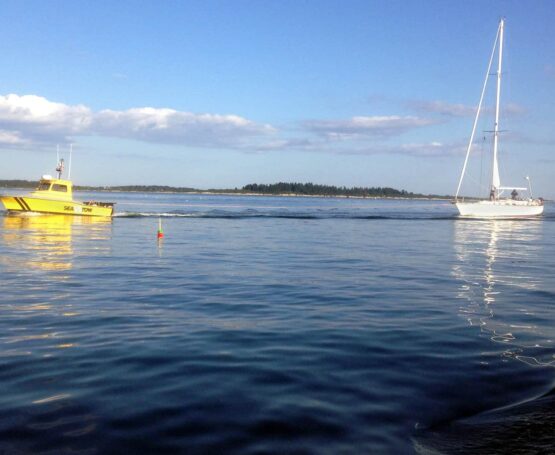
While many experienced sailors rightly take pride in being self-reliant and self-sufficient, stuff happens. That is particularly true in Maine, where tide and currents, occasional thick fog, and rocky ledges require considerable vigilance. And no matter how careful you are, sooner or later, you will probably snag a lobster buoy. Depending on the circumstances, it might be easy to extricate yourself, but other times might require a dive to cut the line off your prop. If you’re short-handed or find yourself in a strong current and not enough wind to sail, things can get tricky. Every summer, numerous yachters find themselves in situations where the prudent thing to do is call for outside assistance.
At least two companies offer nationwide maritime assistance and towing insurance: Sea Tow and Boat US. For a very reasonable annual fee (less than $200 in 2022), they will come to your assistance with 100% of the cost covered by your membership. If unable to help you themselves, they will reimburse the cost of towing incurred from another licensed tower (up to generous limits). Being a member of either service gives you priority over calls for assistance from non-members. Both services cover the entire coastline of Maine, with the popular Penobscot Bay to Jonesport area serviced for both companies through a reputable agent, Charlie’s Marine Services in Rockland. If sailing beyond Jonesport, you might have trouble getting a towing company to travel that far in a practical timeframe. However, Maine and Canadian lobster fishers in the waters near the border are known to be especially helpful. A VHF request on channel 16 or a cellphone call to the Eastport Harbormaster (Richard Clark at 207-853-4614) will likely yield a solution.
Having never had towing insurance before, as the author gets older and less inclined to want to dive on a fouled prop in Maine waters, I opted to take insurance and joined Sea Tow, having personally heard good feedback about them. Whether you ever need to call for assistance or not, keep in mind that you can often help yourself out of a difficult situation. If there is any breeze, you might be able to sail to an anchorage to address the issue. If there is no wind, consider tying your dinghy alongside and motoring to shelter. I once lost a blade from a feathering prop on passage from Spain to the Canary Islands. After sailing the last few hundred miles, the wind died within sight of a safe harbor at Lanzarote. An approaching deep low-pressure system gave urgency to the situation. We found that our inflatable with its 6 HP engine lashed alongside, pushed our 20,000# 40-foot sailboat along at 3+ knots into the marina. It was long after dark when we glided close alongside a large luxury sailing yacht tied to the dock, its crew and guests well into their cocktails. We surprised them when we called over that we had no engine, and they scrambled ashore to catch our lines and arrest our momentum.
Sea Tow and BoatUS Towing have websites with further details of coverage.

